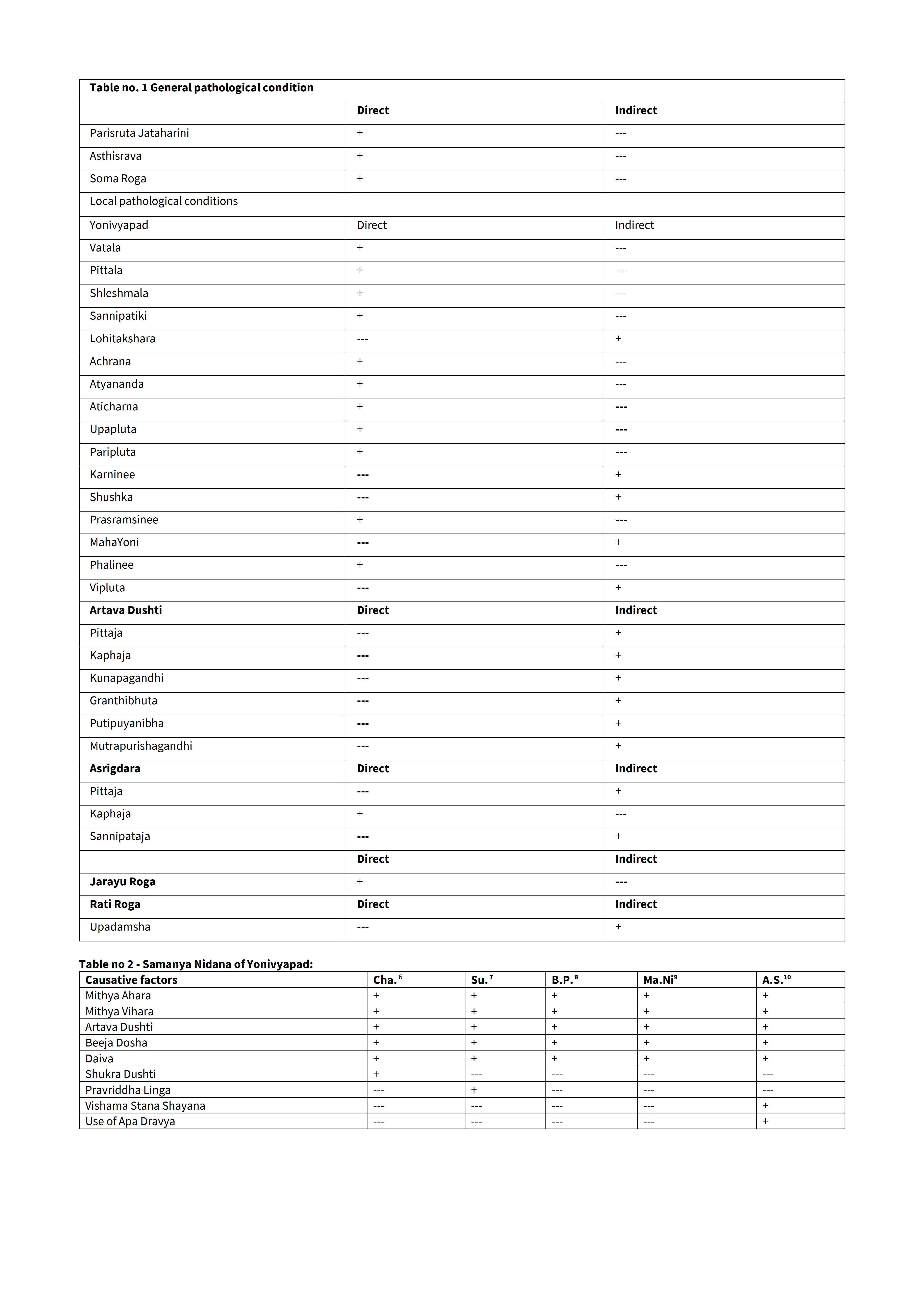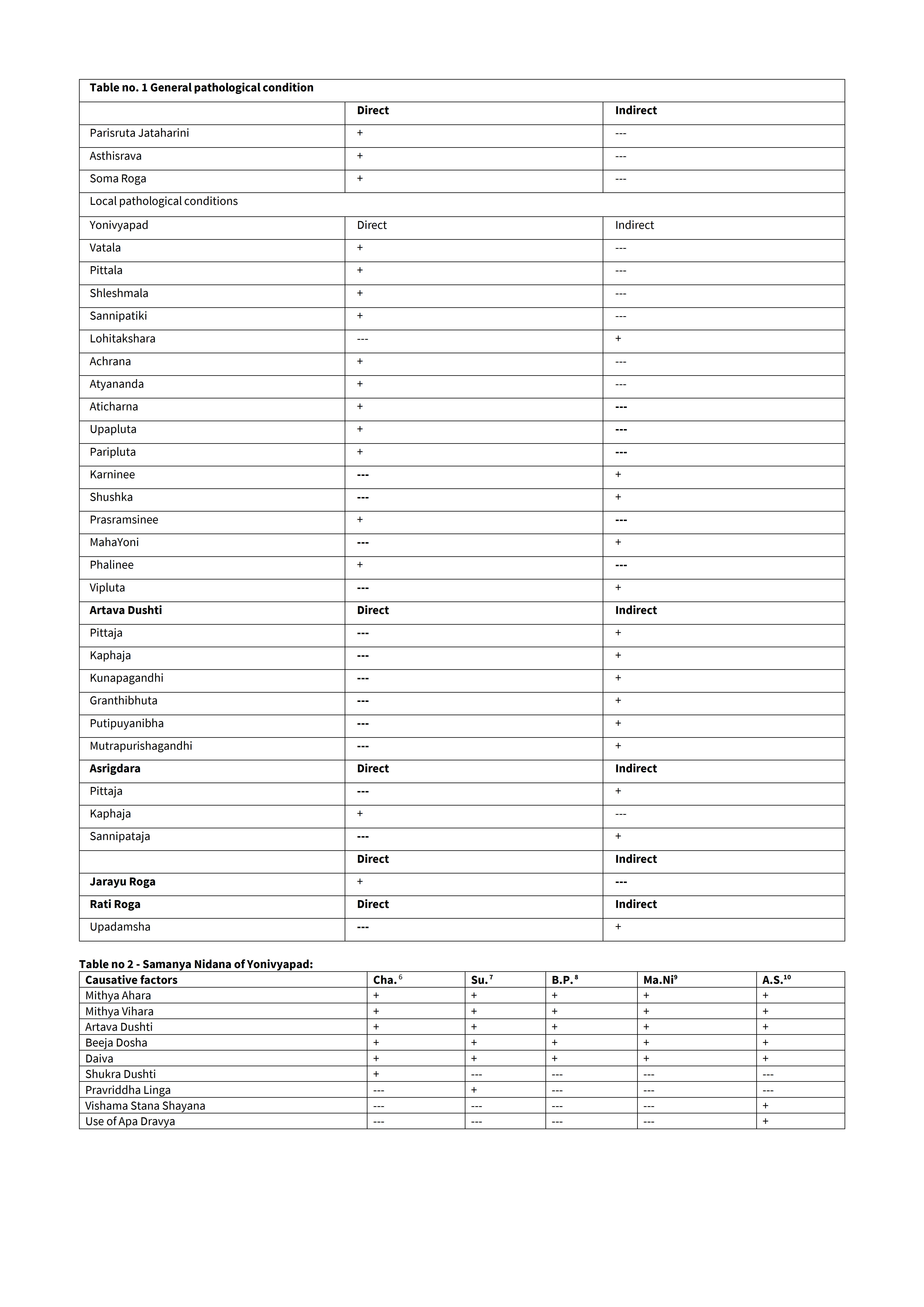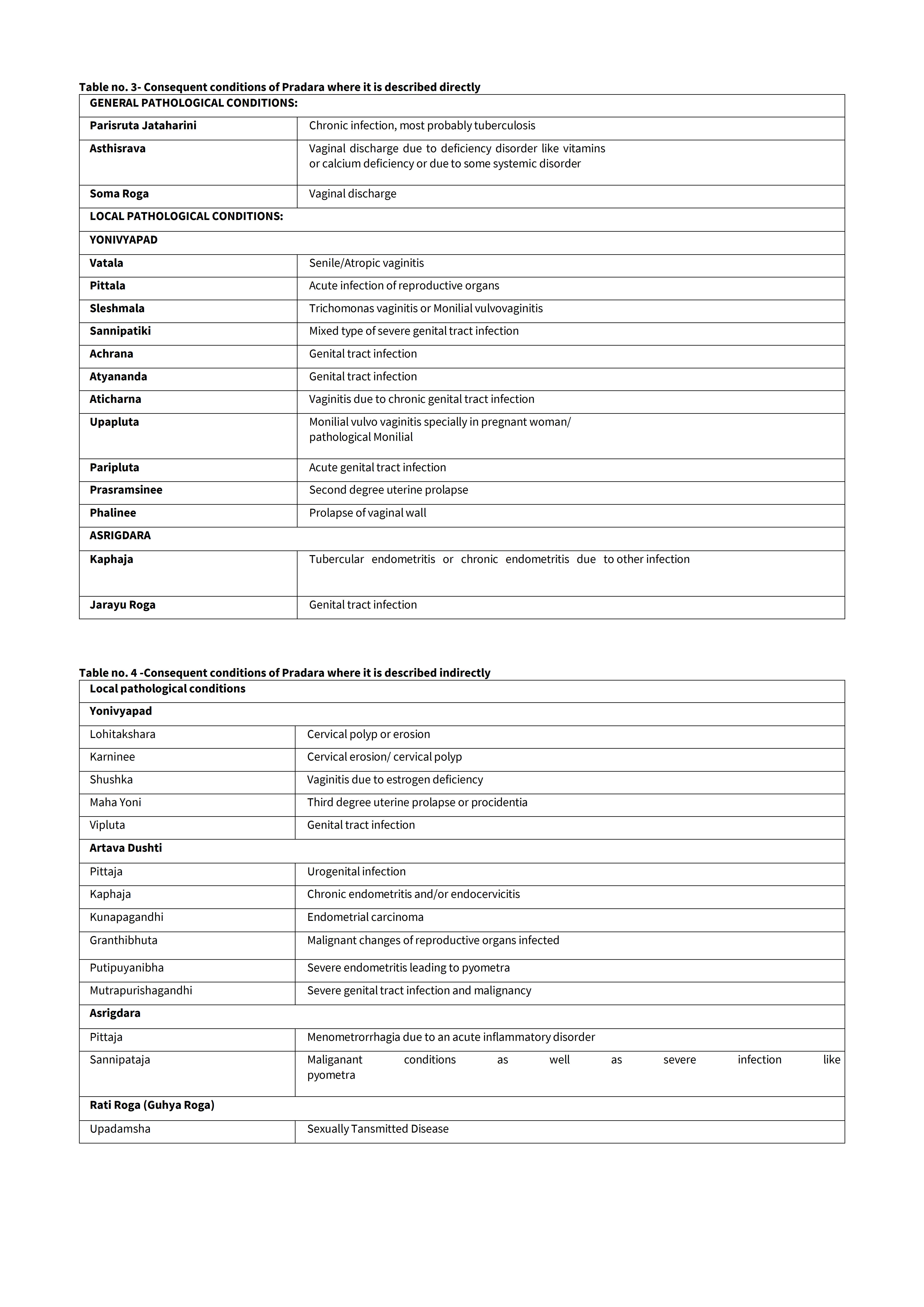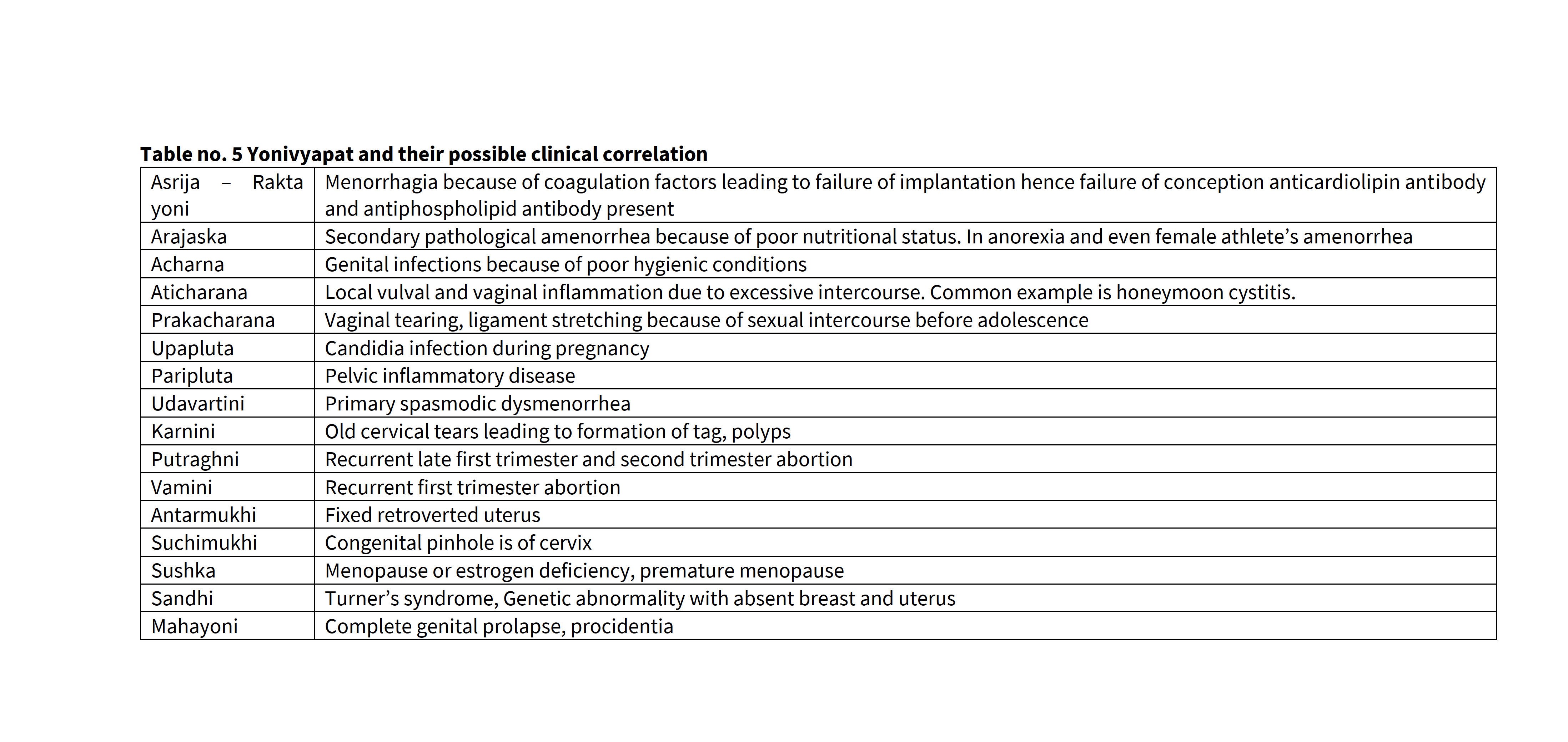Review Article
Year: 2021 |Volume: 2 | Issue: 11 |Pages: 55-64
Concept of Yoni Srava in different pathological condition in Yonivyapada.
About Author
Correspondence Address:
Dr. Nitin Sarangdhar Gawande MS -Final year (streeroga and prasuti tantra) Dr.D.Y.Patil College of Ayurveda and research centre pimpri pune. email ID -dr.nitinsgawande3@gmail.com
Date of Acceptance: 2021-12-15
Date of Publication:2021-11-28
Article-ID:IJIM_125_01_22 http://ijim.co.in
Source of Support: nil
Conflict of Interest: nil
How To Cite This Article: Gawande N S, Patil J R. Concept of Yoni Srava in different pathological condition in Yonivyapada. Int J Ind Med 2021;2(11):55-64
Abstract
As female is considered to be the root of a healthy offspring. Women has to do more efforts to counter this extra burden. Moreover, the woman is said to be three times more responsible than male in the procreation. She has to bear the reproduction and bringing up of children. For this she should be in the perfect, healthy condition, particularly reproductive healthiness. physical and psychological factors directly affect her attitude and efficacy, which adversely affects the family. Owing to complicated structure of the female body, women are subjected to a large number of complaints, connected with genital organ. Yonivyapada is a compilation of various disorders of the genital tract eg. Vulva, uterus. Which produces different types of Srava in different conditions. Any changes in color, consistency, amount, smell of discharge may be a sign of a vaginal infection. Vaginal infections are very common during reproductive period of women.
Keywords: Yonivyapada, Yoni Srava, Stree Roga, Vaginal discharge
Introduction
In women abnormal vaginal discharge is the most common factor which creates annoyance in women daily work. Normal vaginal discharge may appear clear, cloudy white and without any types of smell. Changes in normal discharge can be caused by many reasons such as menstrual cycle, emotional stress, nutritional status, pregnancy, usage of medications -including birth control pills and sexual arousal. Infections, therefore, are most common at this time. Pathological conditions of female genital track manifest as changes in color(varna), consistency, amount, smell(gandha) of discharge (Srava). In ayurveda Pradara means excess or increased degree (which indicates excessive flow).1 pradara has been described as a symptom in many ancient classics. Almost all the Acharyas have mentioned Yoni Srava, but the references are scattered in description of different disease entities.
- Physiological srava
- Pathological srava
Menstrual cycle)4
During Menstrual cycle,the color, consistency, and amount can also change from day to day, depending on where a person is in their menstrual cycle:
a) Days 1–5. At the beginning of the cycle, discharge is usually red or bloody, as the body sheds the uterine lining.
b) Days 6–14. Following a period, a person may notice less vaginal discharge than usual. As the egg starts to develop and mature, the cervical mucus will become cloudy and white or yellow. It may feel sticky.
c) Days 14–25. A few days before ovulation, the mucus will be thin and slippery, similar to the consistency of egg whites. After ovulation, the mucus will go back to being cloudy, white or yellow, and possibly sticky or tacky.
d) Days 25–28. The cervical mucus will lighten, and a person will see less of it, before getting another period.
Samanya Nidana of Yonistrava: 5
All the Stree Roga can be included into “vishanti yonivyapad” and “Yonitah Srava” Lakshana is described in various Yoni Vyapad. General causes of this disease discribed by Acharya Charaka
Mithya Achara11: The heading includes Mithya Ahara and Vihara both.
Mithya Ahara: The diets, which are Kapha Vardhaka, are the main etiological factors for Shwetapradara. But vitiation of Pitta and Vata due to Pitta and Vata Vardhaka Ahara also plays an important role in the manifestation of disease.
Mithya Vihara: It means abnormal mode of life. Coitus in abnormal body postures, coitus with weak or young woman by a man possessing good sized penis, use of foreign bodies during sexual act.
Manasika Hetu:
-
Acharya Sharangadhara has enumerated three disorders of women caused by inexperience of the husband, co-wife and destiny. These appear to be psychological disorders peculiar to the women.
-
Acharya Charaka and Vagbhatta, when described the Streekara Bhava, mainly Asahana (intolerance), Moha (mental confusion), Anawasthana (fickling nature) etc. Bhavas are described.
-
All above Manasika Hetus promote various Stree Roga like Shwetapradara.
" ROWS="50" class="form-control">
1. Physiological Srava: 2
Ghrita melts when it come in contact with fire, like wise women secret Artava during coitus. Acharya had also described that when two hypersexual women indulge in sexual act; they secrete Sukra in each other, which results in fetus devoid of bones. Acharya Vagbhatta has clarified it and said that a physiological discharge of women which is secreted during the sexual act is incapable of conception. Practically, in human being coitus does not initiate ovulation, thus it is not advisable to accept Artava (Stree Shukra) excreted during coitus as ovum, this may be considered only as local discharges of female reproductive system coming out during coitus.
2. Pathological Srava:
Various general & local pathological conditions described as a causative factor of abnormal discharge in modern science are mentioned here as yonivyapada. Out of them, in some conditions Yonisrava described directly as a symptom and others conditions.
Types of vaginal discharge according modern 3
There are several different types of vaginal discharge. Which are categorized based on their color and consistency. Some types of discharge are normal others are abnormal.
a)White: white discharge, especially at the beginning or end of your menstrual cycle, is normal. However, if the discharge is accompanied by itching and has a thick, cottage cheese-like consistency or appearance, This type of discharge may be a sign of a yeast infection.
b)Clear and watery
A clear and watery discharge is perfectly normal. It can occur at any time of the month. It may be especially heavy after exercise.
c)Clear and stretchy
When discharge is clear but stretchy and mucous-like, rather than watery, it indicates that you are likely ovulating. This is a normal type of discharge.
d)Brown or bloody
Brown or bloody discharge is usually normal, especially when it occurs during or right after your menstrual cycle. A late discharge at the end of your period can look brown instead of red. You may also experience a small amount of bloody discharge between periods. This is called spotting.
e)Yellow or green
A yellow or green discharge, especially when it’s thick, chunky, or accompanied by an unpleasant smell, isn’t normal. This type of discharge may be a sign of the infection trichomoniasis. It’s commonly spread through sexual intercourse.
Yonisrava during Rituchakra(Menstrual cycle)4
During Menstrual cycle,the color, consistency, and amount can also change from day to day, depending on where a person is in their menstrual cycle:
a) Days 1–5. At the beginning of the cycle, discharge is usually red or bloody, as the body sheds the uterine lining.
b) Days 6–14. Following a period, a person may notice less vaginal discharge than usual. As the egg starts to develop and mature, the cervical mucus will become cloudy and white or yellow. It may feel sticky.
c) Days 14–25. A few days before ovulation, the mucus will be thin and slippery, similar to the consistency of egg whites. After ovulation, the mucus will go back to being cloudy, white or yellow, and possibly sticky or tacky.
d) Days 25–28. The cervical mucus will lighten, and a person will see less of it, before getting another period.
Samanya Nidana of Yonistrava: 5
All the Stree Roga can be included into “vishanti yonivyapad” and “Yonitah Srava” Lakshana is described in various Yoni Vyapad. General causes of this disease discribed by Acharya Charaka
Mithya Achara11: The heading includes Mithya Ahara and Vihara both.
Mithya Ahara: The diets, which are Kapha Vardhaka, are the main etiological factors for Shwetapradara. But vitiation of Pitta and Vata due to Pitta and Vata Vardhaka Ahara also plays an important role in the manifestation of disease.
Mithya Vihara: It means abnormal mode of life. Coitus in abnormal body postures, coitus with weak or young woman by a man possessing good sized penis, use of foreign bodies during sexual act.
Manasika Hetu:
-
Acharya Sharangadhara has enumerated three disorders of women caused by inexperience of the husband, co-wife and destiny. These appear to be psychological disorders peculiar to the women.
-
Acharya Charaka and Vagbhatta, when described the Streekara Bhava, mainly Asahana (intolerance), Moha (mental confusion), Anawasthana (fickling nature) etc. Bhavas are described.
-
All above Manasika Hetus promote various Stree Roga like Shwetapradara.
Types of vaginal discharge according modern 3
There are several different types of vaginal discharge. Which are categorized based on their color and consistency. Some types of discharge are normal others are abnormal.
a)White: white discharge, especially at the beginning or end of your menstrual cycle, is normal. However, if the discharge is accompanied by itching and has a thick, cottage cheese-like consistency or appearance, This type of discharge may be a sign of a yeast infection.
b)Clear and watery
A clear and watery discharge is perfectly normal. It can occur at any time of the month. It may be especially heavy after exercise.
c)Clear and stretchy
When discharge is clear but stretchy and mucous-like, rather than watery, it indicates that you are likely ovulating. This is a normal type of discharge.
d)Brown or bloody
Brown or bloody discharge is usually normal, especially when it occurs during or right after your menstrual cycle. A late discharge at the end of your period can look brown instead of red. You may also experience a small amount of bloody discharge between periods. This is called spotting.
e)Yellow or green
A yellow or green discharge, especially when it’s thick, chunky, or accompanied by an unpleasant smell, isn’t normal. This type of discharge may be a sign of the infection trichomoniasis. It’s commonly spread through sexual intercourse.
Yonisrava during Rituchakra(Menstrual cycle)4
During Menstrual cycle,the color, consistency, and amount can also change from day to day, depending on where a person is in their menstrual cycle:
a) Days 1–5. At the beginning of the cycle, discharge is usually red or bloody, as the body sheds the uterine lining.
b) Days 6–14. Following a period, a person may notice less vaginal discharge than usual. As the egg starts to develop and mature, the cervical mucus will become cloudy and white or yellow. It may feel sticky.
c) Days 14–25. A few days before ovulation, the mucus will be thin and slippery, similar to the consistency of egg whites. After ovulation, the mucus will go back to being cloudy, white or yellow, and possibly sticky or tacky.
d) Days 25–28. The cervical mucus will lighten, and a person will see less of it, before getting another period.
Samanya Nidana of Yonistrava: 5
All the Stree Roga can be included into “vishanti yonivyapad” and “Yonitah Srava” Lakshana is described in various Yoni Vyapad. General causes of this disease discribed by Acharya Charaka are

table 1

table 2

table 3

table 4
Discussion
Vaginal discharge is the common symptom of a variety of diseases each of which has a distinct treatment. Many women have what they perceive as an abnormal vaginal discharge at some point in their lives, but usually it is just a normal physiological discharge. This is a white or clear, non-offensive discharge that varies with the menstrual cycle. Bacterial vaginosis and yeast infections are the most frequently encountered causes of a vaginal discharge. However, there are numerous other potential aetiologies, both infective and non-infective, that need to be considered in the differential diagnosis. In different Yonivyapada different yonisrava is mentioned. Yonivyapat can be correlated with following modern conditions possibly.
Conclusion
Pradara has been described as a symptom in many ancient classics. Pradara means excess or increased degree (which indicates excessive flow). Vaginal discharge is one of common problem of women, and represents an even greater proportion of visits to gynecologic offices and sexually transmitted disease clinics. It has a morbidity that includes pain, time lost from work, sexual unhappiness, family disruption, sexual transmission of disease, systemic illness, and infertility. If physician understands the samprapti in a proper way he will never fail in the management Yonisrava(Vaginal discharge).
References
-
Pandit Kashinath Nath Shastri and Dr Gorakh Nath Chaturvedi editor, Achaya Charaka, Charak Samhita (Uttarardha), Hindi Translation, Reprint, Varanasi, Chaukhambha Sanskrit Series, 2002 p. 858.
-
Sushruta, Sushruta Samhita of Mahrshi Sushruta , Sharira Sthana 2/50, edited with Ayurveda-Tattva-Sandipika Hindi Commentary, scientific analysis, notes etc. by Kaviraja Ambikadutta Shastri, 10th edition,1996, publisher: Chaukhambha Bharti Academy, Varansi.pp.-20.
-
https://www.healthline.com/health/dizziness#types accessed on 20 nov 2021
-
Eschenbach DA, Thwin SS, Patton DL, Hooton TM, Stapleton AE, Agnew K, Winter C, Meier A, Stamm WE. Influence of the normal menstrual cycle on vaginal tissue, discharge, and microflora. Clinical Infectious Diseases. 2000 Jun 1;30(6):901-7.
-
Agnivesha, Charaka Samhita, Chikitsa Sthana ,30 /8 pe Tika revised by Charaka and Dridhabala with the Ayurveda-Dipika Commentary of Cakrapanidatta and with Vidyotini, Vaidya Yadavji Trikamji Acharya, introduction by Acharya Priyavata Sharma, Part II, publisher: Chaukhambha Bharti Academy, Reprint – 2006, Chaukhamabha Bharti Academy, Printers: Charu Printers, Varansi.pp-841 .
-
Agnivesha, Charaka Samhita, Chikitsa Sthana ,30 /7-8 pe Tika revised by Charaka and Dridhabala with the Ayurveda-Dipika Commentary of Cakrapanidatta and with Vidyotini, Vaidya Yadavji Trikamji Acharya, introduction by Acharya Priyavata Sharma, Part II, publisher: Chaukhambha Bharti Academy, Reprint – 2006, Chaukhamabha Bharti Academy, Printers: Charu Printers, Varansi.pp-841 .
-
Sushruta, Sushruta Samhita of Mahrshi Sushruta , Uttara Sthana 38/3-6, edited with Ayurveda- Tattva-Sandipika Hindi Commentary, scientific analysis,notes etc. by Kaviraja Ambikadutta Shastri, 10th edition,1996, publisher: Chaukhambha Bharti Academy, Varansi.pp.-156.
-
Bhavamisra, Bhavaprakasa of sri Bhavamishra, Purva Khanda, Prathama Bhage, Trutiya Garbhprakarna, edited with the Vidyotini Hindi Commentary Notes, Introduction, index etc., By Bhisagratna Pandita Sri Brahma Sankara Misra, purva khanada 70/1 publisher Chaukhambha orientalia, 5th edition 1993 Chaukhambha Orientalia, Varansi,pp.-764
-
Sri Madhavakara, Madhava Nidanam of Sri Madhavakara, Uttarardha 47, with the “Madhukosha? Sanskrita Commentary by Srivijayarakshita and Srikanthadatta with the Vidyotini Hindi Commentary and notes by Sri Sudardana Sastri, Revised & edited by Prof. Yadunandana Upadhyaya , publisher Chaukhambha Prakashan, Reprint: 2009, Charu printer, Varansi,pp-345
-
Shrimadh Vriddha Vagbhata Vicharitha, Indu tika , Astanga samagraha, Uttarstan 38/32 Chaukambha sanskrit sansthana, Varanasi, pno- 332
-
Agnivesha, Charaka Samhita, Chikitsa Sthana, 30/8 Chak. edited by Dr. Gangasahaya Pandeya, foreword by Vaidya Yadavji Trikamji Acharya, introduction by Acharya Priyavata Sharma, Part II, publisher: Chaukhambha Bharti Academy, Reprint – 2006, Chaukhamabha Bharti Academy, Printers: Charu Printers, Varansi.pp.-751.
"

